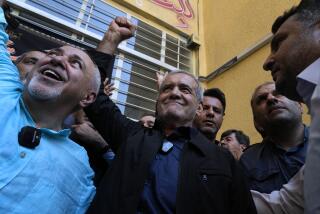A Cult Is Trying to Hijack Our Iran Policy
- Share via
About 15,000 people, most of them Iranian Americans or exiles, recently flocked to Washington to denounce the fundamentalist Islamic government of Iran. The crowd shouted slogans against Iran’s reviled clerical regime and hoisted placards encouraging President Bush to take whatever action necessary -- including preemptive military strikes -- to ensure that Iran did not develop nuclear weapons.
By all appearances, the march seemed like a protest by concerned Iranians who supported regime change in Iran. In reality, it was a meticulously orchestrated political rally in support of a violent, pseudo-Marxist Iranian religious cult -- the People’s Mujahedin of Iran, also known as the Mujahedin Khalq (MEK) -- an organization that has been on U.S. and European Union terrorist watch lists for years.
Ever since the invasion of Iraq, the MEK (and its Paris-based political front, the National Council of Resistance in Iran) has tried to establish itself as the Iranian equivalent of Ahmad Chalabi’s “government in exile,” the Iraqi National Congress -- and not without success. Like the INC before the war, the MEK has advocates in the highest levels of government. And like the INC, the MEK has been inundating the U.S. intelligence community with uncorroborated and, according to some intelligence officials, highly suspect information meant to encourage the White House to carry out the same policy of regime change in Iran that it did in Iraq. But the United States will probably discover that the MEK -- just like the INC -- can’t be trusted.
The MEK, formed in the 1960s as one of several anti-imperialist organizations struggling to overthrow the oppressive and corrupt regime of Shah Mohammed Reza Pahlavi, gained widespread fame by killing dozens of the shah’s political cronies, as well as several U.S. soldiers and civilian contractors who were working in Iran at the time. But after the shah’s expulsion in 1979, the MEK found itself left behind in the ensuing power struggle over who would control the new Iran. Neither the secular democrats who formed the provisional government nor the religious factions who followed Ayatollah Ruhollah Khomeini wanted anything to do with the MEK’s Marxist agenda.
With the establishment of clerical control, the MEK was eventually outlawed and forced to flee to Iraq, where in exchange for assistance and intelligence during the Iran-Iraq war it was provided with protection and arms by Saddam Hussein. It was the MEK’s support for Hussein during that war that has made it the most reviled group in Iran. In fact, the MEK -- now perhaps 10,000 strong, half of them fighters -- may be the only group the Iranian population detests more than the ruling clerical establishment.
The cease-fire between Iran and Iraq in 1988 put the MEK in a vulnerable position. Isolated in remote camps along the border between Iraq and Iran, the group gradually transformed from a revolutionary Marxist guerrilla organization into a fanatical cult of personality centered on absolute devotion to its husband-and-wife leaders, Maryam and Massoud Rajavi.
As with most cults, it is incredibly difficult to break through the veil of secrecy that shrouds the MEK. However, based on the research of Baruch College history professor Ervand Abrahamian, who has written extensively on the group, and the testimony of former members, a horrifying history of terrorist activity, mass murder and human rights abuses has emerged.
From their headquarters in Paris, the Rajavis rule the MEK with draconian, god-like authority. Every morning, MEK members living in the Iraqi camps -- many who joined the group as orphaned children -- line up and salute pictures of Maryam and Massoud. Indeed, when French authorities arrested Maryam Rajavi in 2002 for her involvement in terrorist activities, nine of her followers immolated themselves in protest.
According to Human Rights Watch, members who have criticized the Rajavis or their organization have been detained against their will; some committed suicide. As the public face of the MEK, the National Council of Resistance in Iran presents itself as a democratic and egalitarian organization, often flaunting the number of women in its political and military hierarchy. But this is not so much a sign of progressivism as it is a result of the group’s control mechanisms. The Rajavis have outlawed all contact between their male and female followers. Celibacy is strictly enforced, and all members must undergo weekly ideological cleansings in which they publicly confess their sexual desires. Married couples live apart, save, of course, for Maryam and Massoud.
After the U.S.-led invasion of Iraq, members of the MEK were rounded up and detained by the U.S. military. The Iranians, eager to get their hands on them, entered into negotiations with U.S. officials for a prisoner exchange, offering Taliban and Al Qaeda fighters they had captured in return for members of the MEK. The Iraqis, who wanted to see the group brought to justice for its role in the massacre of the Shiites and Kurds after the Persian Gulf War, supported the negotiations. However, before talks could conclude, the MEK was inexplicably granted protected status under the Geneva Convention. It seems that some members of the U.S. Congress and Bush administration now deem the MEK to be the most viable alternative to Iran’s clerical regime. Thus, during last weekend’s rally, Rep. Bob Filner (D-San Diego) referred to the group as “our best bet to counter the [Iranian] regime.”
The MEK is nothing of the sort. This is a fanatical cult that, despite its rhetoric, has no interest in replacing Iran’s clerical regime with a democratic alternative. On the contrary, its leaders want to replace the clerics with themselves. They want to substitute one kind of religious totalitarianism with another.
Tantalizing promises aside, we must not be fooled.
More to Read
Sign up for Essential California
The most important California stories and recommendations in your inbox every morning.
You may occasionally receive promotional content from the Los Angeles Times.










